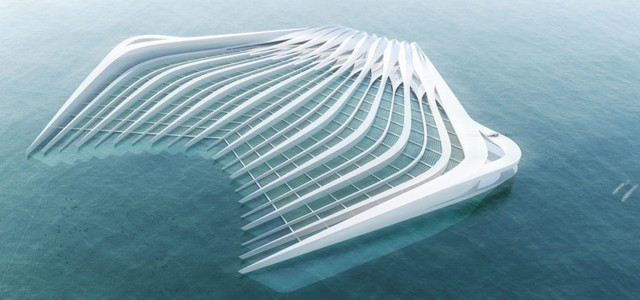A German architect has designed a contraption to free the seas from waste: its floating platform will easily filter plastic out of the water.
It looks like a giant comb and could save our oceans – the Pacific Garbage Screening (PGS). Though the device is still in development, the idea is a promising one. PGS is a giant floating platform that can filter plastic waste from the oceans through its innovative design. Removing this garbage from the oceans would further save the lives of thousands of sea creatures, since fish, mammals, and birds are regularly put at risk due to tangling or ingestion.
How Pacific Garbage Screening Works
Plastic doesn’t only float on the ocean’s surface – a large amount of garbage is also just below the waves. Ocean currents and turnovers pull plastic underwater, the majority of which can be found in the first 175 feet under the surface. Without currents, the plastic would float on the surface just as it does in a swimming pool, since plastic is lighter than water.
The PGS platform is designed in such a way to calm these currents, returning the underwater plastic to the surface. 115-foot-long “keels“ under the contraption form a kind of canal system over 3.5 football fields in length.
“Water flows through the canal system, thus selectively calming ocean movement,” explained Marcella Hansch, the project’s creator. The plastic then rises to the surface due to its own buoyancy and can ultimately be skimmed out of the ocean.
“Based on our initial calculations, we know the principle works,” said Hansch. The PGS project was her architecture master’s thesis. Since designing the device herself four years ago, her support team now consists of a 15-person team of volunteers.
The biggest advantage of this platform compared with similar projects? “The system requires no nets, screens, or filter systems that could be dangerous for marine life,” said Hansch. Plastic waste can simply be collected from the surface of the water.
On Duty in the Great Pacific Garbage Patch
Global ocean currents have caused garbage to collect in five giant trash vortexes on the open seas. In the Pacific, the Great Pacific Garbage Patch – one of these trash vortexes – has collected an extreme amount of plastic waste. PGS could be put to work in such hotspots to remove garbage from the oceans.
The platform can take advantage of natural ocean currents to increase efficacy. With a total surface area of 13 football fields, it could be anchored to the ocean floor to work nonstop in such trouble spots. The anchor would position only the front of the platform (the open side of the comb), ensuring the construction were always optimally oriented toward the current.
The rear of the PGS houses the engine room, storage, and living quarters for crew. The inventor also envisions the platform functioning as a research station.
From Waste to New Resources
Ocean plastics are weakened by salt water and cannot be recycled. But rather than burning them for fuel on land, Hansch and her team have conceived another use: they want to convert this waste to hydrogen and carbon dioxide by means of the so-called plasma gasification process. The resulting hydrogen can be used for fuel cells which can power the entire operation.
The carbon dioxide could be used to feed algae specially cultivated on the surface of the water inside the contraption. This algae biomass could be the raw material for biodegradable algal plastics, thus closing the resource loop. “These final steps still require further research,” said Hansch.
Highly Symbolic Project
The PGS platform won’t be swimming the seas any time soon – the project is still looking for an investor. The nonprofit organization supporting the PGS hopes to finance the necessary research, pilot projects, and construction of original prototypes via a combination of research grants, crowdfunding, and donations.
The contraption addresses all significant aspects of the problem of garbage in our oceans – from the removal of trash from the water to its processing to the production of an environmentally friendlier material. Even if the details remain a bit hazy, such an explicitly holistic approach makes the project an exciting – and hopefully viable – future alternative.
By Annika Flatley
German Version of this article: Utopia.de
More from utopia.org:
This article was translated from German into English. You can view the original here.
** Links to retailers marked with ** or underlined orange are partially partner links: If you buy here, you actively support Utopia.org, because we will receive a small part of the sales proceeds. More info.Do you like this post?






